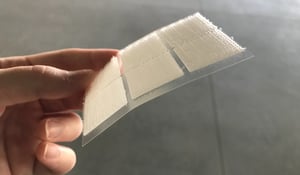From sheeted stickers to the split tabs on the backs of Band-Aids, many inventions stem from a particular production process that increases part usability: kiss cutting.
Kiss cutting is a shallow cutting method that allows engineers to integrate more functionality into customer solutions while keeping costs low. It is well-suited for pressure-sensitive materials, yet when performed incorrectly, it can lead to numerous potential headaches, like defects and increased fallout.
As a converter that uses die cutting services daily, Strouse has witnessed efficiency skyrocket as a result of kiss cut integration in production and assembly. Today, we’ll explain how it creates a smoother manufacturing process.
What is Kiss Cutting?
Kiss cutting uses a die tool to cut material, except that the tooling is adjusted only to cut the top layer(s) of laminate, leaving the liner, backing, or remaining layers untouched.
.png?width=1200&height=430&name=Adhesive%20(5).png)
Kiss cutting is a type of die cutting, but die cutting also includes through cuts. Its name originates from the idea of a blade cutting through one material but barely touching the second. This can leave a slight imprint, but the second layer should remain unpenetrated.
PRODUCT EXAMPLES
Kiss die cutting is performed on rotary, flat bed, or laser machine presses.
 The product shown above is a pressure-sensitive adhesive that has been kiss cut to a liner. Strouse then die cuts (through cuts) the part into squares.
The product shown above is a pressure-sensitive adhesive that has been kiss cut to a liner. Strouse then die cuts (through cuts) the part into squares.
.png?width=300&height=150&name=Untitled%20design%20(52).png)
The next product actually utilizes two levels of kiss cuts. On the left, you can see a through cut slice through the black adhesive and its backing to the clear carrier. On the right, a kiss cut halts after the first cut without damaging the tan layer underneath. This kiss cut area creates a tab for the part, allowing for easy removal of the backing once the part is removed from the transparent liner and placed on a substrate. The center is also kiss cut in order to remove the adhesive in that particular location.
Comparison to Die Cutting
In the converting industry, we often hear the term kiss cut used with die cut; however, kiss cutting is a form of die cutting.
Die cutting is a process consisting of through cuts (which pass fully through a material) and kiss cuts (which pass partially through a material); both are necessary to construct adhesive parts. For instance, you could kiss cut shallow sticker shapes on a sticker sheet for easier peeling, but to cut the actual sheet smaller, you’d use a through cut to cleave the whole paper in two.
The Advantages and Disadvantages of Kiss Cutting
One of the most significant advantages of kiss cuts is their convenience. It’s an excellent method for arranging a high quantity of parts into individual groupings for commercially sold products.
ADVANTAGES
1. HIGH-QUALITY PRODUCTION
Kiss cutting allows you to have firm control over the production process. By making slight adjustments as the kiss cut pieces travel through the equipment, a converter can achieve tighter tolerances as they’re turned into roll form. This process consolidates operations, allowing converters to manufacture complex products in fewer steps. As a result, the machines don't continue running for as long, which saves time and money.
2. BETTER SHIPPING AND HANDLING
Kiss cut adhesives can be distributed to the customer in either roll or sheet form, which results in more organized storage than loose parts.
Rolled products require less labor to transport and are significantly more cost-effective. Companies can also automate them for production straight off the shelf. Additionally, rolled products experience minimal human contact from raw material to packaged product transformation, ideal in industries like medicine, where one might need to avoid cross-contamination.
3. EASIER USE
Another crucial point to consider is the actual application of the adhesive. Keeping the parts aligned in rows makes them easier and quicker to access and transport on the job. Moreover, kiss cutting enables you to add features such as tabs or extended liners, which help contribute to better accessibility.
DISADVANTAGES
PROCESS COMPLEXITY
When done incorrectly, kiss cut products will exhibit additional defects that hinder their use.
For example, the cut’s depth can make or break the product's functionality. A too-deep cut might cause the adhesive to seep into the kiss cut itself and "lock up" the delivery material or liner. However, if the kiss cut is too shallow, the parts may appear fine to the naked eye, but when you remove them, they are non-functional, as they are still stuck together.
The tooling is very sensitive and requires close monitoring to ensure the exact cuts are made every time.
A defective kiss cut roll might be wound too tightly or with inconsistent tension, triggering many potential issues, such as shifted parts or parts stuck to the backside of the delivery material, which could hinder automation.
Build Effective Kiss Cut Products
Kiss cutting allows manufacturers to build sophisticated production processes that run smoothly and produce easy-to-use products.
If you’re interested in getting started with die cuts, check out some of these resources that go over the basics:
- Die Cut Machines vs. Hiring a Converter: Which is Better?
- Everything You Need To Know About Die Cut Adhesives
Of course, while research is an excellent way to find the best production methods, there’s nothing like having a replica of your design to test. To prototype one of your designs or materials, contact a flexible material converter for a sample.
Otherwise, feel free to take a closer look at our Learning Center for more information on die cutting.
Originally published: July 12, 2022







